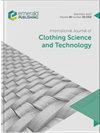Coloring and functional properties of cotton and wool fabrics treated with aronia (Aronia melanocarpa) fruit and leaf extracts
IF 1
4区 工程技术
Q3 MATERIALS SCIENCE, TEXTILES
International Journal of Clothing Science and Technology
Pub Date : 2023-04-04
DOI:10.1108/ijcst-02-2022-0019
引用次数: 2
Abstract
PurposeThe purpose of this study was to develop an environment-friendly finishing process for coloring and functionalizing fabrics using the extracts from aronia fruit (AF) and/or aronia leaf (AL).Design/methodology/approachColoring and functional compounds were extracted from both AF and AL to prepare dyeing and finishing agents for textiles. The bioactive compounds were identified, and their concentrations were determined by spectrophotometry and high-performance liquid chromatography. The extracts were then used to dye and finish natural fibers. The cotton and wool fabrics treated with AF, AL and a combination of AF + AL extracts were investigated in terms of coloring properties and functionalities, specifically antioxidant capacity and antibacterial property.FindingsAccording to the obtained results, AF extracts contained significant amounts of anthocyanins and phenols while AL extracts contained higher amounts of phenols with very low levels of anthocyanins. It was successfully demonstrated that the AF and AL extracts can be used to dye fabrics with good color properties. Moreover, textiles treated with aronia extracts inhibited the growth of gram-negative and gram-positive bacteria and exhibited antioxidant properties.Originality/valueAF extract showed superior coloring and functional properties compared to AL extract. However, the treatment solution containing both AF and AL extracts demonstrated significant synergic effects on the antibacterial and antioxidant properties of the treated fabrics.用野樱草(aronia melanocarpa)果实和叶片提取物处理棉毛织物的着色和功能特性
目的本研究的目的是开发一种环保的织物着色和功能化整理工艺,该工艺使用龙舌兰果实(AF)和/或龙舌兰叶(AL)的提取物。设计/方法/方法从AF和AL中提取着色化合物和功能化合物,制备纺织品染整剂。通过分光光度法和高效液相色谱法对生物活性化合物进行了鉴定,并测定了它们的浓度。然后用提取物对天然纤维进行染色和整理。研究了AF、AL和AF+AL提取物处理的棉和羊毛织物的着色性能和功能,特别是抗氧化能力和抗菌性能。结果表明,AF提取物中含有大量的花青素和酚类物质,而AL提取物中含有较高含量的酚类物质且花青素含量极低。结果表明,AF和AL提取物可用于织物的染色,具有良好的色彩性能。此外,用阿罗尼亚提取物处理的纺织品抑制了革兰氏阴性菌和革兰氏阳性菌的生长,并表现出抗氧化特性。与AL提取物相比,Originality/valueAF提取物显示出优异的着色和功能特性。然而,同时含有AF和AL提取物的处理溶液对处理织物的抗菌和抗氧化性能表现出显著的协同作用。
本文章由计算机程序翻译,如有差异,请以英文原文为准。
求助全文
约1分钟内获得全文
求助全文
来源期刊
CiteScore
2.40
自引率
8.30%
发文量
51
审稿时长
10 months
期刊介绍:
Addresses all aspects of the science and technology of clothing-objective measurement techniques, control of fibre and fabric, CAD systems, product testing, sewing, weaving and knitting, inspection systems, drape and finishing, etc. Academic and industrial research findings are published after a stringent review has taken place.

 求助内容:
求助内容: 应助结果提醒方式:
应助结果提醒方式:


